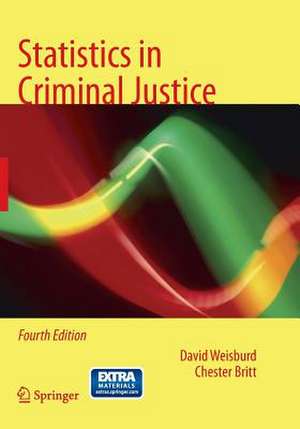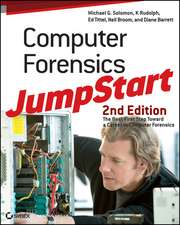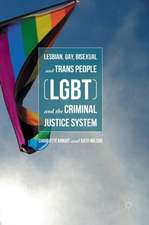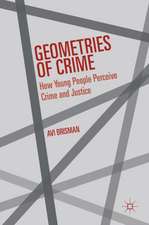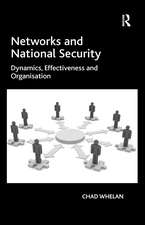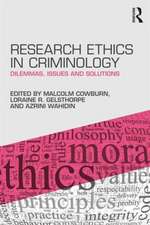Statistics in Criminal Justice
Autor David Weisburd, Chester Britten Limba Engleză Paperback – 30 apr 2017
New to the 4th Edition
· New chapter on experimental design and the analysis of experimental data.
· New chapter on multi-level models, including growth-curve models.
· New computer exercises throughout the text to illustrate the use of both SPSS and Stata.
· Revision of exercises at the end of each chapter that places greater emphasis on using statistical software.
· Additional resources on the text’s web site for instructors and students, including answers to selected problems, syntax for replicating text examples in SPSS and Stata, and other materials that can be used to supplement the use of the text.
| Toate formatele și edițiile | Preț | Express |
|---|---|---|
| Paperback (2) | 554.96 lei 6-8 săpt. | |
| Springer Us – 28 oct 2010 | 554.96 lei 6-8 săpt. | |
| Springer Us – 30 apr 2017 | 1499.40 lei 6-8 săpt. | |
| Hardback (1) | 1034.62 lei 6-8 săpt. | |
| Springer Us – 11 dec 2013 | 1034.62 lei 6-8 săpt. |
Preț: 1499.40 lei
Preț vechi: 1828.53 lei
-18% Nou
Puncte Express: 2249
Preț estimativ în valută:
286.91€ • 312.63$ • 241.76£
286.91€ • 312.63$ • 241.76£
Carte tipărită la comandă
Livrare economică 23 aprilie-07 mai
Preluare comenzi: 021 569.72.76
Specificații
ISBN-13: 9781489977625
ISBN-10: 1489977627
Pagini: 783
Ilustrații: XVII, 783 p. 81 illus., 5 illus. in color.
Dimensiuni: 178 x 254 x 41 mm
Greutate: 14.8 kg
Ediția:Softcover reprint of the original 4th ed. 2014
Editura: Springer Us
Colecția Springer
Locul publicării:New York, NY, United States
ISBN-10: 1489977627
Pagini: 783
Ilustrații: XVII, 783 p. 81 illus., 5 illus. in color.
Dimensiuni: 178 x 254 x 41 mm
Greutate: 14.8 kg
Ediția:Softcover reprint of the original 4th ed. 2014
Editura: Springer Us
Colecția Springer
Locul publicării:New York, NY, United States
Cuprins
Introduction: Statistics as a Research Tool.- Measurement: The Basic Building Block of Research.- Representing and Displaying Data.- Describing the Typical Case: Measures of Central Tendency.- How Typical is the Typical Case?: Measuring Dispersion.- The Logic of Statistical Inference: Making Statements about Populations from Sample Statistics.- Defining the Observed Significance Level of a Test: A Simple Example Using the Binomial Distribution.- Steps in a Statistical Test: Using the Binomial Distribution to make Decisions about Hypotheses.- Chi-Square: A Test Commonly Used for Nominal-Level Measures.- The Normal Distribution and its Application to Tests of Statistical Significance.- Comparing Means and Proportions in Two Samples.- Comparing Means Among More Than Two Samples.- Measuring the Association for Nominal and Ordinal Variables.- Measuring Association for Interval-Level Data.- An Introduction to Bivariate Regression.- Multivariate Regression.- Multivariate Regression: Additional Topics.- Logistic Regression.- Multivariate Regression with Multiple Category Nominal or Ordinal Measures.- Growth Curve Modeling.- Hierarchical Design.- Special Topics: Confidence Intervals.- Special Topics: Statistical Power.- Special Topics: Experimental Design.- Appendices.- Glossary.- Index.
Notă biografică
David Weisburd (Ph.D., Yale University) is a leading researcher and scholar in the field of criminal justice. He is Professor of Criminology at the Hebrew University Law School in Jerusalem and is a professor in the Department of Criminology and Criminal Justice at the University of Maryland. Professor Weisburd serves as a senior fellow at the Police Foundation in Washington DC, and is a member of the National Academy of Sciences Panel on Police Practices and Polices and the steering committee of the Campbell Crime and Justice Coordinating Group. Chester Britt (Ph.D, University of Arizona) is a researcher and scholar in the field of criminology. He is Associate Professor in the Administration of Justice Department at Arizona State University West. Professor Britt is the editor for Justice Quarterly. He has published more than twenty scientific articles and book chapters on issues related to the demography of crime, criminal careers, criminal case processing, and statistics.
Textul de pe ultima copertă
Statistics in Criminal Justice takes an approach that emphasizes the application and interpretation of statistics in research in crime and justice. This text is meant for both students and researchers who want to gain a basic understanding of common statistical methods used in this field. In general, the text relies on a building-block approach, meaning that each chapter helps to prepare the student for the chapters that follow. It also means that the level of sophistication of the text increases as the text progresses. Throughout the text there is an emphasis on comprehension and interpretation, rather than computation. However, as the statistical methods discussed become more complex and demanding to compute, there is increasing use and integration of statistical software. This approach is meant to provide the reader with an accessible, yet sophisticated understanding of statistics that can be used to examine real-life criminal justice problems with popular statistical software programs. The primary goal of the text is to give students and researchers a basic understanding of statistical concepts and methods that will leave them with the confidence and the tools for tackling more complex problems on their own.
New to the 4th Edition:
• New chapter on experimental design and the analysis of experimental data.
• New chapter on multi-level models
• More advanced discussions of statistical power, multi-nomial and ordinal regression.
• New computer exercises throughout the text to illustrate the use of both SPSS and Stata.
• Revision of exercises at the end of each chapter that places greater emphasis on using statistical software.
• Additional resources on the text’s web site for instructors and students, including answers to selected problems, syntax for replicating text examples in SPSS and Stata, and other materials that can be used to supplement the use of the text.
New to the 4th Edition:
• New chapter on experimental design and the analysis of experimental data.
• New chapter on multi-level models
• More advanced discussions of statistical power, multi-nomial and ordinal regression.
• New computer exercises throughout the text to illustrate the use of both SPSS and Stata.
• Revision of exercises at the end of each chapter that places greater emphasis on using statistical software.
• Additional resources on the text’s web site for instructors and students, including answers to selected problems, syntax for replicating text examples in SPSS and Stata, and other materials that can be used to supplement the use of the text.
Caracteristici
New edition contains two new chapters, computer exercises with SPSS and Stata
Written for use as a classroom text and suitable as a reference for researchers
Emphasizes and illustrates how different types of criminal justice research influence the outcome of statistical results
Uses real-life examples of criminal justice research
Includes running glossary, chapter summaries, and exercises applicable to the criminal justice field
Includes supplementary material: sn.pub/extras
Written for use as a classroom text and suitable as a reference for researchers
Emphasizes and illustrates how different types of criminal justice research influence the outcome of statistical results
Uses real-life examples of criminal justice research
Includes running glossary, chapter summaries, and exercises applicable to the criminal justice field
Includes supplementary material: sn.pub/extras
Descriere
Descriere de la o altă ediție sau format:
Statistics in Criminal Justice takes an approach that emphasizes the uses of statistics in research in crime and justice. This text is meant for students and professionals who want to gain a basic understanding of statistics in this field. The text takes a building-block approach, meaning that each chapter helps to prepare the student for the chapters that follow. It also means that the level of sophistication of the text increases as the text progresses. Throughout the text there is an emphasis on comprehension and interpretation, rather than computation. However, it takes a serious approach to statistics, which is relevant to the real world of research in crime and justice. This approach is meant to provide the reader with an accessible but sophisticated understanding of statistics that can be used to examine real-life criminal justice problems. The goal of the text is to give the student a basic understanding of statistics and statistical concepts that will leave the student with the confidence and the tools for tackling more complex problems on their own. Statistics in Criminal Justice is meant not only as an introduction for students but as a reference for researchers.
A number of changes have been made to the 3rd edition, including the following:
- Additional exercises at the end of each chapter
- Expanded computer exercises that can be performed in the Student Version of SPSS
- Extended discussion of multivariate regression models, including interaction and non-linear effects
- A new chapter on multinomial and ordinal logistic regression models, examined in a way that highlights comprehension and interpretation
- With the additional material on multivariate regression models, the text is appropriate for both undergraduate and beginning graduate statistics courses in criminal justice
Statistics in Criminal Justice takes an approach that emphasizes the uses of statistics in research in crime and justice. This text is meant for students and professionals who want to gain a basic understanding of statistics in this field. The text takes a building-block approach, meaning that each chapter helps to prepare the student for the chapters that follow. It also means that the level of sophistication of the text increases as the text progresses. Throughout the text there is an emphasis on comprehension and interpretation, rather than computation. However, it takes a serious approach to statistics, which is relevant to the real world of research in crime and justice. This approach is meant to provide the reader with an accessible but sophisticated understanding of statistics that can be used to examine real-life criminal justice problems. The goal of the text is to give the student a basic understanding of statistics and statistical concepts that will leave the student with the confidence and the tools for tackling more complex problems on their own. Statistics in Criminal Justice is meant not only as an introduction for students but as a reference for researchers.
A number of changes have been made to the 3rd edition, including the following:
- Additional exercises at the end of each chapter
- Expanded computer exercises that can be performed in the Student Version of SPSS
- Extended discussion of multivariate regression models, including interaction and non-linear effects
- A new chapter on multinomial and ordinal logistic regression models, examined in a way that highlights comprehension and interpretation
- With the additional material on multivariate regression models, the text is appropriate for both undergraduate and beginning graduate statistics courses in criminal justice
